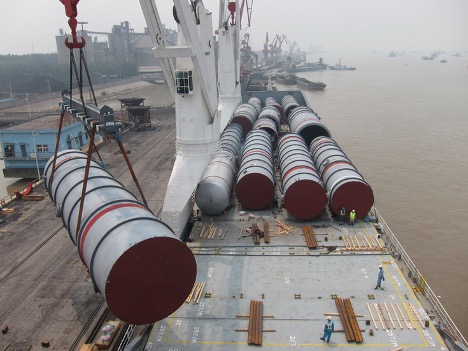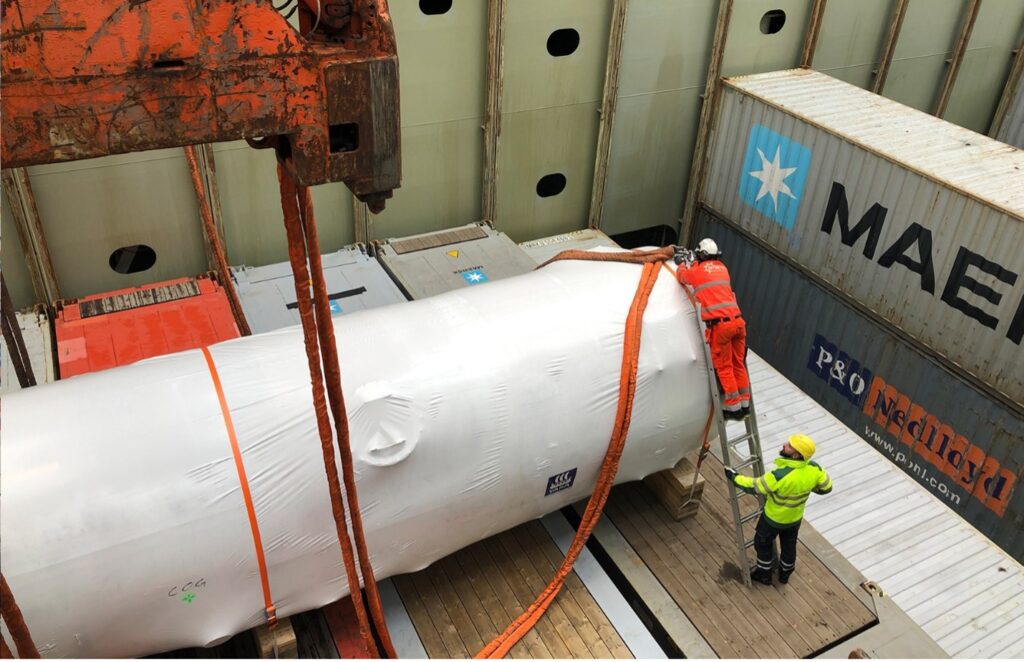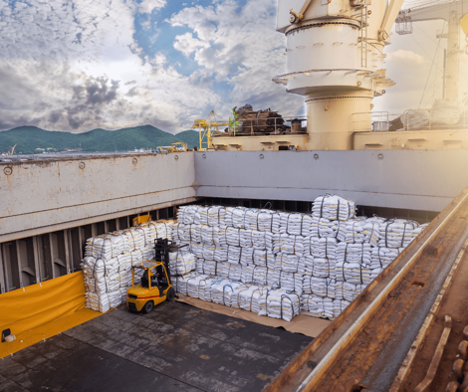Break bulk ships are a type of cargo vessel that transport individual goods in separate packages, crates, or pallets. They are designed to accommodate different sizes and shapes of cargo, which is loaded and unloaded using cranes, forklifts, and other heavy machinery.
Unlike container ships that carry standardized shipping containers, break bulk ships are used to transport project cargo, oversized cargo, and non-containerized goods such as vehicles, machinery, and construction equipment.

History of Break Bulk Shipping
The concept of break bulk shipping dates back to the early days of maritime trade when goods were transported in barrels, bales, and sacks. The advent of containerization in the 1950s revolutionized the shipping industry and made it possible to transport large quantities of goods more efficiently.
However, break bulk shipping remains an important method of cargo transport, particularly for industries such as oil and gas, mining, and construction that require the transportation of heavy and oversized cargo including sailboats and yacht transportation.
Types of Break Bulk Ships
Break bulk shipping is an important mode of transportation for a wide range of goods, and different types of break bulk ships are designed to cater to specific cargo needs. Here are some more detailed descriptions of the most common types of break bulk ships:
- General Cargo Ships – General cargo ships are versatile vessels that can transport a wide range of goods, including break bulk cargo, containers, and dry bulk cargo such as grain and coal. These ships typically have adjustable cargo holds and are equipped with cranes or derricks to facilitate the loading and unloading of cargo. General cargo ships are ideal for shipping diverse and mixed cargo loads, making them a popular choice for both import and export trade.
- Ro-Ro Ships – Ro-Ro ships, short for Roll-on/Roll-off ships, are designed to transport rolling cargo such as cars, trucks, and heavy machinery. These vessels have built-in ramps that allow vehicles to be driven on and off the ship, making loading and unloading more efficient. Ro-Ro ships come in different sizes and can cater to various cargo types, from small personal vehicles to large trucks and buses.
- Heavy Lift Ships – Heavy lift ships are designed to transport cargo that is too heavy or large to be loaded onto regular cargo ships. These ships have large cranes that can lift heavy objects and move them onto the ship. Heavy lift ships come in various sizes and types, and their lifting capacities can range from several hundred to thousands of tons. Heavy lift ships are ideal for transporting large and heavy equipment, such as oil rig components, offshore wind turbines, and other oversized cargo.
- MPP (Multipurpose) ships – MPP ships are designed to carry a variety of cargo, including break bulk cargo, containers, and dry bulk cargo such as grain and coal. MPP ships have the advantage of being able to adapt to different types of cargo, making them a flexible option for shipping companies. They also typically have cranes and other equipment onboard to facilitate the loading and unloading of cargo. Therefore, MPP ships can be a useful addition to the list of Break Bulk Ships.

In addition to their cargo-specific designs, break bulk ships offer several benefits over other shipping modes. For example, break bulk shipping allows for greater flexibility in cargo loading and unloading, which can be beneficial for time-sensitive or high-value cargo. It also allows for more efficient use of space on the ship, as cargo can be stacked and arranged to maximize the available space. Moreover, break bulk shipping can be more cost-effective than other modes of transportation, particularly for smaller cargo loads.
Examples of break bulk shipping routes include the transportation of machinery for oil and gas industries, wind turbines, steel products, and other heavy equipment and even boat and yacht transportation. These cargoes are often transported using heavy lift ships or general cargo ships, depending on their size and weight.
Break bulk shipping is a crucial mode of transportation for various types of cargo, and different types of break bulk ships are designed to cater to specific cargo needs. General cargo ships, Ro-Ro ships, MPP ships, and heavy lift ships are the most common types of break bulk ships, each with unique features and advantages.

Advantages and Disadvantages of Break Bulk Shipping
Break bulk shipping has both advantages and disadvantages compared to container shipping. Let’s explore these in more detail:
Advantages of Break Bulk Shipping
Flexibility: One of the significant advantages of break bulk shipping is its flexibility. Break bulk shipping can accommodate different types of cargo with varying shapes and sizes, making it an excellent choice for oversized or irregularly shaped cargo that cannot fit into standard containers. Moreover, it allows shippers to mix various types of cargo in a single shipment, making it ideal for small and medium-sized shipments that do not require a full container.
Lower Cost: Break bulk shipping can be cheaper than container shipping for small and medium-sized shipments. The cost of renting a container can be higher than using break bulk cargo, especially if the cargo does not fit in a standard container. Using break bulk cargo can be a cost-effective alternative to shipping cargo that does not require a full container.
More Secure: Another advantage of break bulk shipping is that it is more secure than container shipping. Since cargo is loaded separately, it is harder for thieves to steal the entire shipment. Moreover, break bulk cargo is usually handled by specialized crews with expertise in securing cargo, ensuring that it arrives safely at its destination.
Disadvantages of Break Bulk Shipping
Slower Transit Times: Break bulk shipping can be slower than container shipping due to the time it takes to load and unload cargo separately. Moreover, break bulk cargo requires more handling, which can increase transit times. This can be a significant disadvantage for time-sensitive shipments.
Higher Risk of Damage: Another disadvantage of break bulk shipping is that it carries a higher risk of cargo damage. Cargo is loaded and unloaded using cranes, which can be less precise than container handling equipment. Moreover, the cargo is often exposed to the elements during loading and unloading, which can increase the risk of damage due to weather conditions.
In conclusion, break bulk shipping has both advantages and disadvantages compared to container shipping. While it offers greater flexibility, lower cost, and more security, it also comes with slower transit times and a higher risk of cargo damage. Ultimately, shippers should evaluate their cargo’s specific needs and choose the best shipping method that meets their requirements.

Future of Break Bulk Shipping
The future of break bulk shipping is a topic of much discussion and speculation within the industry. While containerization has become the preferred method of cargo transportation in recent decades, break bulk shipping still plays a vital role in the global supply chain for certain types of cargo.
One potential area of growth for break bulk shipping is in the renewable energy industry. As the world shifts towards more sustainable sources of energy, there will be a greater need to transport oversized and heavy components such as wind turbine blades, nacelles, and towers, which are too large to fit in standard containers.
Another potential growth area is in the transportation of project cargo, which refers to large, complex shipments that require specialized handling and coordination. This includes equipment for infrastructure projects such as power plants, oil rigs, and pipelines, as well as industrial machinery and mining equipment.
In addition, break bulk shipping is likely to continue to play a role in the transportation of high-value and sensitive cargo, such as military equipment and aerospace components, which require a high level of security and protection.
However, the future of break bulk shipping also faces challenges. The rise of containerization and the consolidation of cargo into larger and larger vessels has made it increasingly difficult for smaller break bulk ships to compete. In addition, the COVID-19 pandemic has had a significant impact on the global shipping industry, leading to disruptions in the supply chain and changes in consumer behavior.
Despite these challenges, break bulk shipping is expected to remain a viable option for certain types of cargo transportation, particularly for oversized and irregularly shaped items that cannot be containerized. As the global economy continues to evolve, the role of break bulk shipping is likely to shift, but it will remain an important part of the global logistics network for many years to come.
Conclusion
Break bulk shipping is a type of cargo transport that involves the transportation of individual goods in separate packages, crates, or pallets. Break bulk ships are designed to accommodate different sizes and shapes of cargo, which is loaded and unloaded using heavy machinery such as cranes and forklifts.
Although container shipping has revolutionized the shipping industry, break bulk shipping remains an important method of cargo transport, particularly for industries that require the transportation of heavy and oversized cargo.
- Types of Gas Carriers as per IGC Code – April 22, 2025
- Wind-Assisted Propulsion Systems (WAPS): A Game Changer for Maritime Decarbonization – February 6, 2025
- 10 Boat Salvage Yards in California – January 25, 2025




